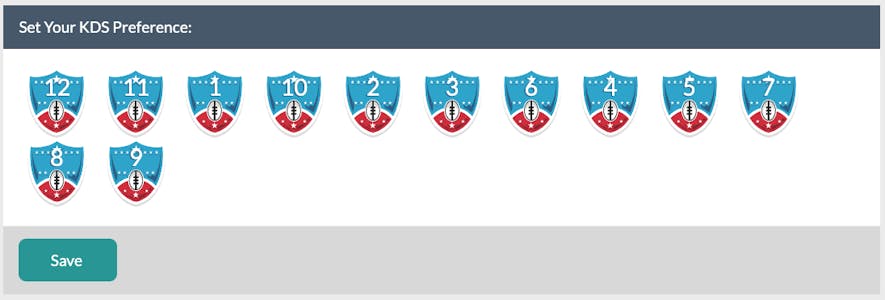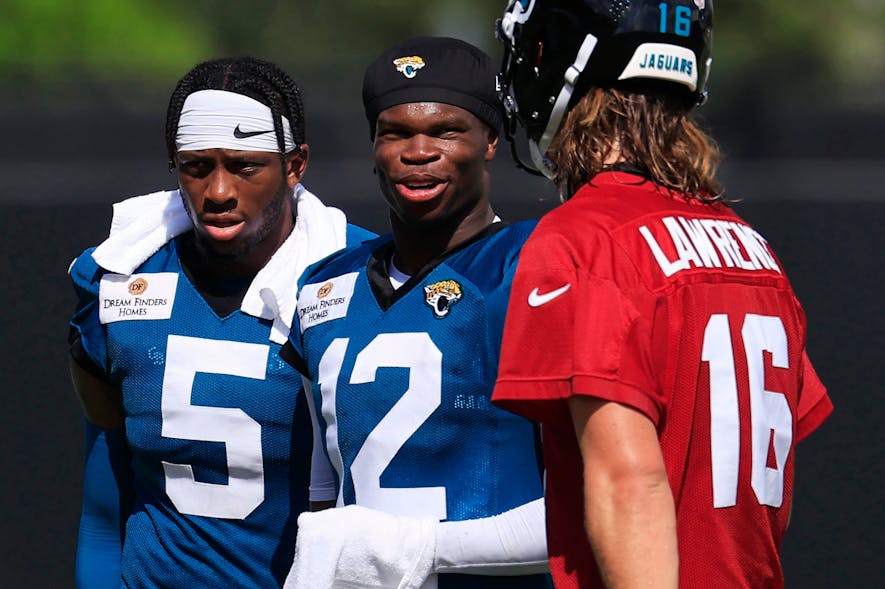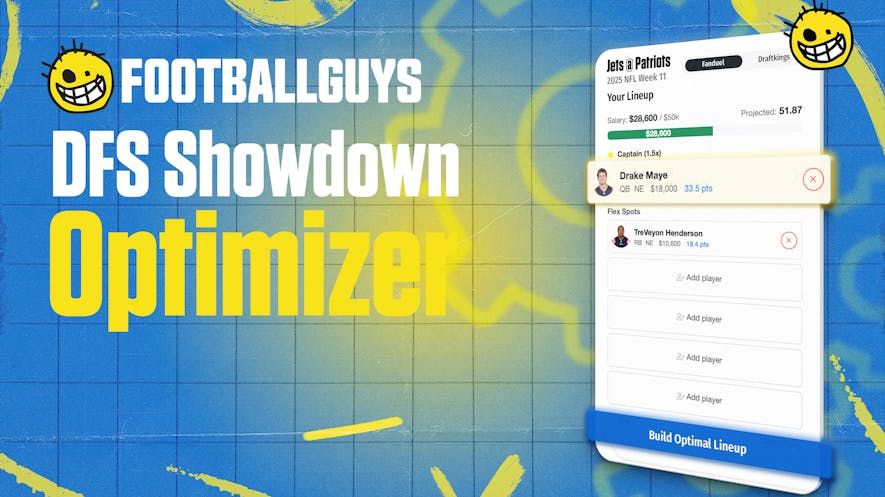After more than 10 years in the fantasy football industry, I finally decided to take the plunge into high-stakes season-long redraft. It's a format I've been eager to explore, but one I hadn't taken the time to fully understand or analyze. That changed this year when Footballguys announced a partnership with the NFFC (National Fantasy Football Championship), and I got access to a rich dataset from their high-stakes drafts. As a data nerd and someone intrigued by the challenge of competing for big money at the highest levels, it felt like the perfect opportunity to do two things at once:
-
Build a suite of powerful draft tools for Footballguys subscribers to help them attack high-stakes contests, and
-
Dive into the action myself by entering the NFFC $350 Online Championship and documenting my process along the way.
To kick off our coverage of this tournament, I'll walk through how I approached my first NFFC draft, which took place on July 30th. In the process, I'll cover:
-
Key rules, scoring settings, and payout structure.
-
How to sign up and select your preferred draft slot.
-
An introduction to the five tools I built and how to use them in your own prep.
-
A breakdown of how my first high-stakes NFFC draft played out and some early thoughts on strategy.
NFFC $350 Online Championship: Format, Scoring, and Payouts
Before diving into draft strategy, it's important to understand exactly how the NFFC $350 Online Championship works. This isn't just another redraft league. It's a well-structured, high-stakes tournament with big prizes and some unique rules.
League Structure
Each Online Championship league consists of 12 teams. For the first 14 weeks of the NFL season, you compete only against the teams in your league. After that, the best teams across all leagues advance to compete for the overall tournament prizes.
-
Weeks 1–3: No head-to-head matchups. Instead, each week, the top six scoring teams in your league earn a win, and the bottom six take a loss.
-
Weeks 4–14: Head-to-head matchups begin, with a perfectly balanced schedule where each team plays every other team once.
At the end of Week 14:
-
1st place in the league (best H2H record, and most total points) wins $1,500
-
2nd place (next-highest total points) wins $700
Overall Championship
The top two finishers from each league automatically qualify for the overall Championship Round. A third team can also qualify from a league if they had more total points than the head-to-head champion. There are also Wild Card spots available. If your team finishes outside the top two in your league but ranks in the top 15 percent of all teams in total points, you still qualify for the overall Championship. If you have a great team that scores a lot of points but runs into some bad luck in terms of head-to-head results, you still move on to the playoffs and get a chance to win the Championship.
All playoff teams carry their weekly scoring average from Weeks 1 through 14 into the playoffs as a starting score. Final standings are determined by adding that average to point totals from Weeks 15 through 17.
The Regular Season Points Leader across all teams (Weeks 1 through 14) wins an additional $1,750 bonus.
Championship and Consolation Payouts
This tournament isn't just top-heavy. In addition to the monster $250,000 awarded to the champion, there are real payouts deep into the playoff standings:
-
1st Place Overall: $250,000
-
2nd Place: $50,000
-
...
-
42nd Place: Wins an extra $440 on top of any league prize
Teams that don't qualify for the Championship Round enter a Consolation Bracket, where the top 15 teams (based on Weeks 15 through 17 scores plus their regular-season average) also win prizes. The Consolation Winner takes home $2,500.
Roster Format and Scoring
The draft is 20 rounds, and starting lineups are set as follows:
- 1 QB
- 2 RB
- 3 WR
- 1 TE
- 1 Flex (RB/WR/TE)
- 1 Team Defense
- 1 Team Kicker
While I'm not generally a fan of kickers, I love that the NFFC uses team kickers instead of individual players. It's a clean workaround with no stress over training camp kicker battles or kicker injuries.
Scoring is full PPR (1 point per reception), with no premium for tight ends. A few other scoring details to note:
-
6 points per passing touchdown (compared to the more common 4-point setup)
-
0.05 points per passing yard (vs. 0.04 in many leagues)
This format boosts the value of traditional pocket passers, making high-volume QBs with strong passing efficiency more viable compared to standard scoring systems.
Draft Format: Third-Round Reversal
One of the more strategic elements of this format is the third-round reversal draft.
If you pick 1.01, you get the 2.12 pick as usual, but instead of getting 3.01, you don't pick again until 3.12. This helps balance out the strong advantage early draft slots often provide, especially in years with elite first-round talent.
How to Sign Up
If you're ready to jump into the action, NFFC has created a dedicated landing page just for Footballguys readers.
It includes more details on the prize structure, roster requirements, and scoring settings if you want to go deeper than what we've covered above. When you're ready to draft, just scroll to the bottom of the page to view your available league options and reserve your spot.
Draft Slot Selection: Kentucky Derby Style (KDS)
NFFC uses a Kentucky Derby Style (KDS) system for draft slot selection. After registering for a league, you rank your preferred draft slots from 1 to 12.
Once leagues are randomly drawn, the system will assign each team the highest-ranked slot still available based on their draft position. That means you can prioritize middle-round slots, avoid certain picks, or chase your favorite draft strategy.
For example, your KDS submission might look like this:
Note: These were my actual preferences I set for my draft.
If you get selected first in your league, you'll be given your top-ranked preference. In my case, that would have been pick 12. However, I landed somewhere lower in priority and ended up with my second choice, 11th overall.
KDS enables you to tailor your draft position to your strategy, rather than leaving it entirely up to chance.
Important Note: Consider your pick preferences before registering. Your KDS preferences need to be saved promptly, as draft spot selection will occur soon after the league fills.
NFFC Tools
To support Footballguys subscribers competing in the NFFC $350 Online Championship, I created five custom tools specifically tailored to this tournament. Each tool is powered by live draft data and designed to help you navigate key decisions during your draft. In the sections that follow, I'll introduce each tool and walk through how I used them to prepare for my own NFFC draft.
Tool #1: Draft Board Explorer
The first tool I turned to during my prep was the Draft Board Explorer. This app updates multiple times per day and automatically loads the full draft board from the most recent $350 Online Championship draft. You can also use the dropdown menu to browse any completed draft from the contest.
This is always my first stop when prepping for a high-stakes draft. One of the best ways to understand how a draft is likely to unfold is to study how real drafts have played out. The Draft Board Explorer makes that easy by showing you full draft results in a clean, scrollable format.
I like to take it a step further by evaluating each team's full roster and asking myself a few key questions:
-
Which teams do I like the most?
-
What draft slot did they come from?
-
Is the strategy they used repeatable if I land in a similar slot?
- For example, I looked at a draft completed on July 28th:
I really liked what teams in the 9-to-12-slots were able to accomplish. My personal rankings have about 18 players I feel especially confident in this season, so picking late in Round 1 guarantees I can pair two of them. Team 9, in particular, stood out as a roster I'd have been thrilled to walk away with.
Despite starting with three straight running backs, they still managed to build plenty of wide receiver depth and upside with players like Chris Olave, Rome Odunze, Ricky Pearsall, Jameson Williams, Jayden Higgins, and Tre Harris.
Scrolling through recent draft boards and identifying your favorite builds is a tremendous starting point for draft planning. The Draft Board Explorer lets you do that in seconds.
Tool #2: NFFC ADP Dashboard
After reviewing full draft boards to get a feel for different roster builds and positional runs, my next stop was the NFFC ADP Dashboard. This tool provides a sharper, data-driven view of where players are actually being drafted across recent contests. Seeing the board from a single draft is helpful, but understanding the average draft position across dozens of recent drafts is critical if you want to make informed decisions on draft day.
The dashboard is built on real draft data from the past three weeks. Here's what you'll find in the table:
-
Current ADP: The average draft position based on all $350 Online Championship drafts from the past 7 days. This is arguably the most valuable prep data available. These aren't mock drafts or outdated results from earlier in the offseason; these are fresh numbers from real, high-stakes contests.
-
Previous ADP: The average draft position from drafts completed 8 to 21 days ago.
-
ADP Change: The difference between Current and Previous ADP. This makes it easy to spot players who are rising or falling in the market.
-
Stack Percentage: The percentage of time each skill-position player was drafted on the same team as his quarterback. This can be useful when evaluating potential stacks, especially if you're aiming to advance deep into the overall tournament and want a more unique roster construction.
-
Fantasy Points Per Game (PPG): Projected points per game using Footballguys Consensus Projections under NFFC scoring rules. This updates daily as projections evolve.
-
PPG Over Replacement (PPGAR): This column compares each player's projected PPG to the replacement-level baseline at their position (e.g., QB15, RB37, WR43, TE15). It gives you a snapshot of how much weekly value a player is expected to add over a baseline starter.
While projections are just one piece of the puzzle, having context on positional leverage is incredibly valuable in a start/sit format like this one.
Here are a few interesting takeaways from the data as of July 31:
-
Six of the top seven players in PPGAR are running backs, with Ja'Marr Chase being the only non-RB to crack the top tier.
-
Brock Bowers ranks 9th overall in PPGAR, highlighting the rare edge he could offer at the tight end position.
-
Joe Burrow ranks 16th in PPGAR. Thanks to the 6-point passing touchdowns and 0.05 points per passing yard, he projects ahead of the four dual-threat QBs typically drafted before him.
The ADP Dashboard is where I go to lock in my understanding of draft cost, positional value, and market trends before building out my player targets and contingency plans.
Tool #3: ADP Explorer
Examining full draft boards and recent ADP trends is a great way to develop a general plan. But once you've identified players you're especially high on, the next step is figuring out exactly how realistic it is to land them from your draft slot.
That's where the ADP Explorer comes in.
This tool allows you to select any player in the pool and view a distribution chart showing where that player has been drafted in every recent draft. You can also select your specific draft slot and see your odds of landing that player at each of your picks.
It's useful both before and after you know your draft slot:
-
Before selecting your KDS preferences, you can use the tool to explore which players are most likely to be available from different slots
-
Once your draft slot is locked in, the tool helps you assess risk and plan fallback options for specific targets
In my case, I drew the 11th pick in my league. One player I was especially interested in was Jameson Williams.
As you can see in the screenshot above, the ADP Explorer indicated a 64.1% chance that he would still be on the board at pick 4.11. Not a lock, but certainly possible. Unfortunately, in my actual draft, he was taken at 4.10—one pick before I was up.
Another player I had my eye on was Calvin Ridley. I knew I wanted to target him near the 4/5 turn, and the Explorer confirmed that this was the right spot.
There was a 92.3% chance he would be available at pick 5.02, but only a 6.4% chance he would fall to 6.11. That told me I couldn't wait.
The ADP Explorer gave me a clear edge in planning how aggressive I needed to be to get my guys and exploring the chances I would be able to land some of my top targets once I knew where I would be drafting.
Tool #4: Stack Explorer
One of the best ways to increase your odds of winning the $250,000 grand prize is by building intentional correlations into your lineup. Stacking, a strategy where you draft a quarterback and one or more of his top pass catchers, is one of the most effective ways to do that.
If your quarterback has a monster week during the fantasy playoffs, there's a good chance at least one of his receivers did too. That correlation can turn a good team into a tournament-winning one.
Take my own draft as an example. I selected Baker Mayfield as my top quarterback. If I'm going to make a run at the overall title, I'll likely need a few big games from him in Weeks 15 through 17. If that happens, there's a strong chance that one or more of his pass catchers also deliver big fantasy performances. Stacking lets you double down on that upside.
The Stack Explorer makes it easy to see how others are building their rosters. It shows the most common QB-pass catcher combinations across all recent drafts, so you can spot popular stacks and decide whether to target or avoid certain builds.
As shown above, there are numerous Joe Burrow–Ja'Marr Chase teams in the field. The tool also allows you to filter by quarterback, for example.
If you drill down on Burrow, you'll see that there are almost three times as many Burrow-Chase teams as there are Burrow–Tee Higgins stacks. That kind of intel can help you build more differentiated lineups, especially if you want exposure to the Cincinnati offense but don't want to be grouped with dozens of similar rosters.
Whether you're looking to stack elite combos or find sneaky tournament leverage, the Stack Explorer gives you a fast, visual way to assess your options.
Tool #5: ADP Movers
The final tool I used in my draft prep was the ADP Movers tool. This dashboard automatically highlights recent market shifts by showing:
- The 10 biggest early-round ADP risers
- The 10 biggest late-round ADP risers
- The 10 biggest early-round ADP fallers
- The 10 biggest late-round ADP fallers
Here were the biggest early-round risers heading into my draft:
This tool was especially helpful for me because four of the top risers in the early rounds were players I had already identified as targets. It was reassuring to see their ADPs climbing, which confirmed that other high-stakes drafters were reacting to the same trends and information.
For example, I ended up drafting Omarion Hampton at pick 26 and Emeka Egbuka at pick 74. Based on recent ADP trends, neither was a reach. Both were rising quickly, and I felt confident making those picks.
Spending time with the ADP Movers chart before your draft is crucial. These are the players whose stock is being influenced by camp reports, injuries, depth chart shifts, and other late-breaking news. They often end up being the most difficult decisions you will face on draft day. You may need to decide how early to take a player climbing the board or whether to trust a falling player who now presents value.
Understanding who is trending and why gives you a real edge when making those calls during the draft.
My Draft Strategy from the 11 Slot
Here is who I actually drafted in the early rounds of my first high-stakes draft:
Coming into the draft, I planned to start with three running backs and two wide receivers through the first five rounds. When I don't go RB-heavy early, I dislike feeling forced to reach for a running back I am not sold on in Rounds 6 to 10, when there are still many strong options at wide receiver available in that range.
Specifically, I planned to target Drake London and Chase Brown at the 1-2 turn. These are two players whose roles and overall talent I am fully sold on. However, my plan was instantly upended when Christian McCaffrey fell to me at 1.11. I was expecting him to go a few picks earlier, and he was a player whom I felt I could not pass on. My plan was further upended when Drake London went off the board right ahead of my pick at 2.02.
When I was on the clock at 2.02, I was torn between Chase Brown and Brian Thomas Jr. I ended up going with Brown. I'm not 100 percent confident it was the right call because I love both guys, but ultimately it came down to pure upside. Brown's touchdown potential in an elite offense, combined with strong projections for receiving and scrimmage yards, made him hard to pass up. Ideally, I would have been able to take Brown at 3.02, but I had a strong feeling this group wouldn't let him slide, and I think his days of falling to the top of the third round are coming to an end. At some point, you just take your guy, and Brown is one of “my guys” this year.
Omarion Hampton is a risky pick at 3.02, but you have to take some swings if you want to place highly overall in a contest with 1000s of entries. This was one of my big swings. The volume could be massive, and I want to bet on this Chargers offense to take a big step forward.
One of the main reasons I wanted a late draft slot was to attack the 4–5 turn, where I had a cluster of primary targets: Ken Walker III, Alvin Kamara, Jameson Williams, and Calvin Ridley. There are also plenty of other players in that range with exciting upside, plus the chance that someone unexpected falls.
Walker was taken, and Kamara was not a real option after starting with three straight running backs. I got sniped on Williams, who went off the board at 4.10. The silver lining was that George Kittle fell into my lap at 4.11, which felt like a nice consolation prize.
On the surface, Calvin Ridley might seem like a boring pick at 5.02, but there's a lot to like once you dig in. Think of it as a high-upside rookie bet. It's not a direct bet like taking Tetairoa McMillan or Travis Hunter, but more of an indirect one on rookie quarterback Cam Ward exceeding expectations. If Ward throws for 4,000 yards and 25 to 30 touchdowns, how does Ridley not smash his ADP?
I was able to land a pair of high-upside young wide receivers at 6.11 and 7.02 with Rome Odunze and Emeka Egbuka.
I was then able to add a WR4 I am more excited about than most, Darnell Mooney, at 8.11, and stacked Baker Mayfield with Egbuka with pick 9.02.
I have a lot riding on my key rookies. If Hampton and Egbuka hit, and Ward is good enough to power a big season for Ridley, I should be in business.













